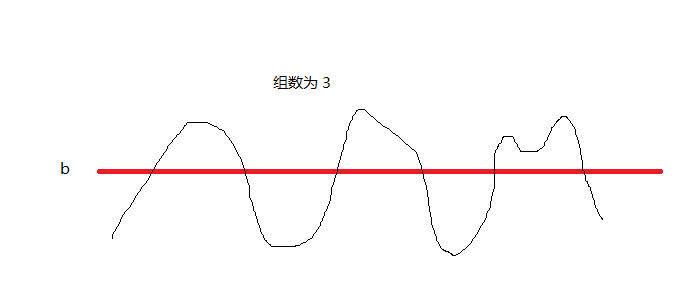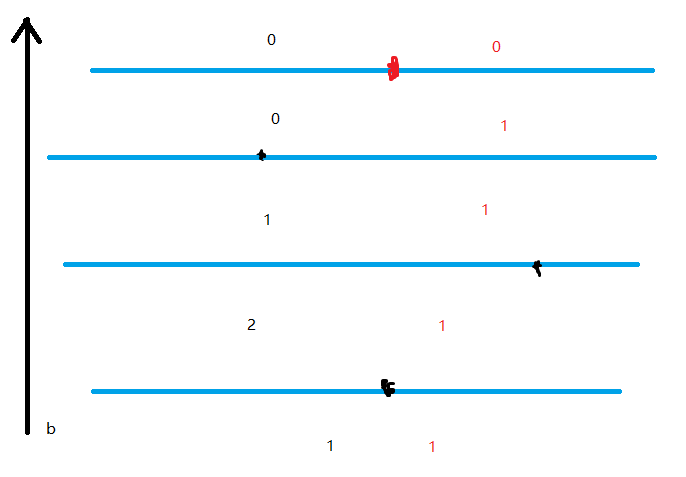[JOISC 2016] 雇佣计划 题解
[JOISC 2016] 雇佣计划 题解
这里补充一篇自己的
本蒟蒻打了两棵线段树,并且进行了繁琐的分类讨论,完全被标算的树状数组吊打 qwq
题意:
给定一个序列
- 将
- 给定一个权值
思路:
首先,我们并不关注每个
然后我们来考虑组数的转化。让我们把所有的
然后发现,这里的
现在我们来考虑修改。我们发现,每一个修改的影响只与这个点和它两侧的点的权值相对大小有关,然后我就去分讨了,写了半天,比如下面这个例子,为了简化模型,我们现在只考虑这三个点的答案:
黑点代表修改前的点,红点代表修改后的点, 黑色的值为修改前的区间内的答案,红色的值为修改后区间内的答案。
对于每一个修改,影响到的区间内答案只有增加一或减小一,所以可以用线段树维护。
而实际上,左右两个点的大小关系是无所谓的,所以一共能分为两大类:权值增大与权值减小,每一类里还有三小类,即修改的点在两侧点下面,在两侧点之间,在两侧点上面。根据修改后的影响范围修改即可(其实这里还要稍微分下类,但是我懒了 xwx)。
具体的分类讨论还是看代码吧……反正很麻烦就对了,自己还是太菜了。
代码:
#include <bits/stdc++.h> using namespace std; const int N = 4e5 + 100; inline int read() { int x = 0; char ch = getchar(); while (ch < '0' || ch > '9') ch = getchar(); while (ch >= '0' && ch <= '9') x = x * 10 + (ch - 48), ch = getchar(); return x; } int a[N], lsh[N]; int totl; struct Questions { int id, val;//id == 0: query. } q[N]; int n, m; struct xwx { int val, id; bool operator < (const xwx &b) const { return val < b.val; } }; priority_queue<xwx> qu; void prework() {//离散化所有出现的权值。 sort(lsh + 1, lsh + totl + 1); totl = unique(lsh + 1, lsh + totl + 1) - lsh - 1; for (int i = 1; i <= n; ++i) { a[i] = lower_bound(lsh + 1, lsh + totl + 1, a[i]) - lsh; qu.push((xwx) { a[i], i }); } for (int i = 1; i <= m; ++i) { q[i].val = lower_bound(lsh + 1, lsh + totl + 1, q[i].val) - lsh; } } int f[N]; #define ls tr<<1 #define rs tr<<1 | 1 struct SegmentTree1 {//第一棵线段树,用来预处理 f struct node { int lc, rc; int ans; } tree[N << 2]; void push_up(int tr) { tree[tr].ans = tree[ls].ans + tree[rs].ans - (tree[ls].rc & tree[rs].lc); tree[tr].lc = tree[ls].lc; tree[tr].rc = tree[rs].rc; } void modify(int tr, int L, int R, int pos) { if (L == R) { tree[tr] = (node) { 1, 1, 1 }; return; } int mid = (L + R) >> 1; if (pos <= mid) { modify(ls, L, mid, pos); } else modify(rs, mid + 1, R, pos); push_up(tr); } int query() { return tree[1].ans; } } s1; struct SegmentTree2 {//第二棵线段树,用来处理修改。 struct node { int val, tag; } tree[N << 2]; //这里R就是值域totl 了 //标记永久化 void build(int tr, int L, int R) { if (L == R) { tree[tr].val = f[L]; return; } int mid = (L + R) >> 1; build(ls, L, mid); build(rs, mid + 1, R); } void modify(int tr, int L, int R, int lq, int rq, int val) { if (lq <= L && R <= rq) { tree[tr].tag += val; return; } int mid = (L + R) >> 1; if (lq <= mid) modify(ls, L, mid, lq, rq, val); if (mid < rq) modify(rs, mid + 1, R, lq, rq, val); } int query(int tr, int L, int R, int pos) { if (L == R) { return tree[tr].tag + tree[tr].val; } int mid = (L + R) >> 1; if (pos <= mid) { return tree[tr].tag + query(ls, L, mid, pos); } else { return tree[tr].tag + query(rs, mid + 1, R, pos); } } } s2; int main() { n = read(), m = read(); for (int i = 1; i <= n; ++i) { a[i] = read(); lsh[++totl] = a[i]; } for (int i = 1; i <= m; ++i) { int op = read(); if (op == 1) { q[i] = (Questions) { 0, read() }; lsh[++totl] = q[i].val; } else { q[i].id = read(), q[i].val = read(); lsh[++totl] = q[i].val; } } prework(); for (int i = totl; i >= 1; --i) { while (qu.size() && qu.top().val >= i) { s1.modify(1, 1, n, qu.top().id);//注意这里的R应该是n!不是值域! qu.pop(); } f[i] = s1.query(); } s2.build(1, 1, totl); for (int i = 1; i <= m; ++i) { if (q[i].id) { int id = q[i].id, del = q[i].val; //这一部分建议结合曲线图来理解修改的区间(三个点的就够) if (id == 1) {//首尾两个点特殊照顾一下。 if (a[id] < del) {//权值增加 if (del > a[id + 1]) {//如果增加的范围超过了右侧点 s2.modify(1, 1, totl, max(a[id + 1], a[id]) + 1, del, 1); } } else if (a[id] > del) {//权值减少 if (a[id] > a[id + 1]) {//如果减少前权值比右侧点大 s2.modify(1, 1, totl, max(a[id + 1], del) + 1, a[id], -1); } } } else if (id == n) {//和 id == 1 类似 if (a[id] < del) { if (del > a[id - 1]) { s2.modify(1, 1, totl, max(a[id - 1], a[id]) + 1, del, 1); } } else if (a[id] > del) { if (a[id] > a[id - 1]) { s2.modify(1, 1, totl, max(a[id - 1], del) + 1, a[id], -1); } } } else { int mx = max(a[id - 1], a[id + 1]), mn = min(a[id - 1], a[id + 1]); //我们只关心两侧点中较大的和较小的值为多少 if (a[id] < del) {//权值增加 if (a[id] < mn) {//修改前比较小值还要小 if (del <= mx) {//修改后没超过较大值 s2.modify(1, 1, totl, a[id] + 1, min(del, mn), -1); } else {//超过了 s2.modify(1, 1, totl, a[id] + 1, mn, -1); s2.modify(1, 1, totl, mx + 1, del, 1); } } else if (a[id] <= mx) {//修改前在两侧权值之间 if (del > mx) {//只有修改后超过较大值才会更新答案 s2.modify(1, 1, totl, mx + 1, del, 1); } } else {//修改前比较大值大 s2.modify(1, 1, totl, a[id] + 1, del, 1); } } else if (a[id] > del) {//权值减少 if (a[id] < mn) {//修改前低于较小值 s2.modify(1, 1, totl, del + 1, a[id], 1); } else if (a[id] <= mx) {//修改前在两侧权值之间 if (del < mn) { s2.modify(1, 1, totl, del + 1, mn, 1); } } else {//修改前在两侧权值上 if (del >= mn) {//如果修改后不低于较小值 s2.modify(1, 1, totl, max(mx, del) + 1, a[id], -1); } else { s2.modify(1, 1, totl, mx + 1, a[id], -1); s2.modify(1, 1, totl, del + 1, mn, 1); } } } } a[id] = del; } else { printf("%d\n", s2.query(1, 1, totl, q[i].val));//单点查询。 } } return 0; }






